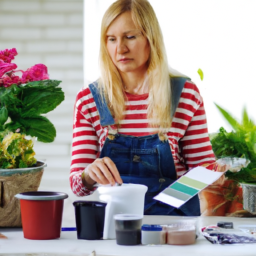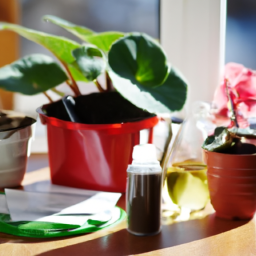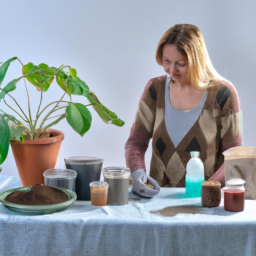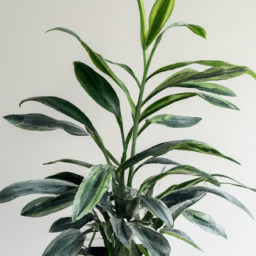
Factors to Consider When Choosing a Potting Mix for Your Plants
Choosing the right potting mix for your plants is crucial for their overall health and growth. The potting mix serves as the foundation for your plants’ root system, providing them with essential nutrients, proper drainage, and aeration. Here are some key factors to consider when selecting the perfect potting mix:
1. Plant Type and Needs
The first step in choosing the right potting mix is to consider the specific needs of your plants. Different plants have different requirements when it comes to moisture retention, nutrient levels, and pH balance. For example, succulents prefer a well-draining mix with low moisture retention, while tropical plants thrive in a mix that retains more moisture.
Research the specific needs of your plants and choose a potting mix that aligns with those requirements. This will ensure that your plants receive the necessary nutrients and moisture for healthy growth.
Additionally, consider the size of your plants. Some potting mixes are formulated for seedlings and small plants, while others are designed for mature and larger plants. Using the right potting mix for the size of your plants will provide them with adequate support and space for root development.
2. Drainage and Aeration
Good drainage and proper aeration are crucial for the health of your plants’ roots. Excess water can lead to root rot and other diseases, while poor aeration can suffocate the roots and hinder their growth.
When choosing a potting mix, look for one that has excellent drainage properties. It should allow excess water to flow through easily, preventing waterlogging. A mix that combines organic materials like peat moss or coconut coir with inorganic components like perlite or vermiculite can provide the ideal balance of drainage and moisture retention.
Aeration is equally important as it allows oxygen to reach the roots. Look for a potting mix that is loose and well-structured, allowing air to circulate freely. Avoid compacted or heavy mixes that can restrict airflow.
3. Nutrient Content
Plants require a variety of nutrients for healthy growth. When selecting a potting mix, consider its nutrient content. Some potting mixes come pre-fertilized, while others may require additional fertilization.
If you choose a pre-fertilized mix, ensure that it contains a balanced blend of essential nutrients like nitrogen, phosphorus, and potassium (NPK). These nutrients are vital for promoting healthy foliage, root development, and overall plant growth.
On the other hand, if you opt for an unfertilized mix, you will need to supplement it with appropriate fertilizers based on your plants’ needs. This gives you more control over the nutrient levels and allows you to customize the fertilization process.
Conclusion
Choosing the right potting mix is essential for the well-being of your plants. Consider the specific needs of your plants, ensuring the mix aligns with their requirements. Pay attention to drainage and aeration properties, as well as the nutrient content of the mix. By selecting the appropriate potting mix, you provide your plants with the ideal environment for healthy growth and thriving.

Understanding the Different Types of Potting Mixes for Plant Care
When it comes to plant care, choosing the right potting mix is crucial for the health and growth of your plants. The potting mix you select will provide the necessary nutrients, moisture retention, and aeration for your plants’ roots. However, with so many options available in the market, it can be overwhelming to determine which potting mix is best for your specific plant needs. In this guide, we will discuss the different types of potting mixes and help you make an informed decision.
1. All-Purpose Potting Mix
All-purpose potting mix is a versatile option suitable for a wide range of plants, including indoor and outdoor plants. It is usually a blend of organic materials such as peat moss, compost, and perlite or vermiculite for added drainage. This type of potting mix provides a good balance of moisture retention and aeration, making it suitable for most plants.
One advantage of all-purpose potting mix is that it is readily available and affordable. It can be used for a variety of plants, including flowers, herbs, vegetables, and small shrubs. However, it is important to note that all-purpose potting mix may not be ideal for plants with specific soil requirements, such as succulents or orchids.
To ensure the best results with all-purpose potting mix, make sure to check the specific needs of your plants and adjust watering and fertilization accordingly.
2. Succulent and Cacti Mix
Succulents and cacti require well-draining soil to prevent root rot and promote healthy growth. A specialized succulent and cacti mix is designed to provide excellent drainage while retaining enough moisture for these plants. This type of potting mix usually contains a combination of coarse sand, perlite, and organic matter.
When using a succulent and cacti mix, it is important to remember not to overwater your plants. Succulents and cacti are adapted to arid conditions and can withstand drought better than excessive moisture. Allow the soil to dry out between waterings and be cautious not to let the plants sit in standing water.
Additionally, succulent and cacti mix should be used for plants that prefer dry conditions and have low water requirements. It is not suitable for plants that thrive in moist or humid environments.
3. Orchid Mix
Orchids are unique plants that have specific soil requirements. They need a potting mix that provides excellent drainage, aeration, and moisture retention. Orchid mixes are typically composed of a combination of organic materials, such as bark, coconut husk, and perlite or charcoal.
Using a specialized orchid mix allows for good air circulation around the roots, preventing root rot. Orchids also benefit from the added nutrients and moisture retention properties of the mix. It is important to note that orchids are epiphytes, meaning they grow on other plants in their natural habitat, so they require a potting mix that mimics their natural environment.
When using an orchid mix, it is crucial to follow the specific care instructions for your orchid species. Different orchids have varying requirements regarding light, water, and humidity levels.
Remember to repot your orchids every couple of years to ensure they have fresh potting mix and enough space for root growth.
Choosing the right potting mix for your plants is essential for their overall health and well-being. By understanding the different types of potting mixes available and their specific benefits, you can provide the optimal growing conditions for your plants. Always consider the specific needs of your plants and adjust watering and fertilization accordingly for the best results.

Essential Components of an Ideal Potting Mix for Healthy Plant Growth
When it comes to growing healthy plants, choosing the right potting mix is of utmost importance. A good potting mix provides the necessary nutrients, aeration, and moisture retention for your plants to thrive. In this article, we will explore the essential components that make up an ideal potting mix and guide you through the process of choosing the right mix for your plants.
1. Organic Matter
Organic matter is a crucial component of any potting mix. It improves the soil structure, enhances water retention, and provides essential nutrients to the plants. Compost, well-rotted manure, and leaf mold are excellent sources of organic matter. These materials add nutrients to the soil and improve its ability to hold moisture without becoming waterlogged.
When selecting a potting mix, look for one that contains a significant amount of organic matter. This will ensure that your plants receive the necessary nutrients for healthy growth. Additionally, organic matter helps to create a favorable environment for beneficial microorganisms that aid in nutrient uptake by the plants.
It’s important to note that different plants have varying requirements for organic matter. For example, plants that thrive in well-draining conditions, such as cacti and succulents, may require a potting mix with a lower percentage of organic matter compared to plants that prefer moisture-retentive soil like ferns or tropical plants.
2. Drainage Material
Proper drainage is essential for the health of your plants. Excess water can lead to root rot and other fungal diseases, so it’s crucial to choose a potting mix that provides adequate drainage. Adding drainage material to your potting mix can help improve the drainage capacity.
One common drainage material is perlite, which is a lightweight volcanic mineral. Perlite helps to create air pockets in the soil, allowing excess water to drain freely. Another option is vermiculite, a mineral that retains moisture while still providing good drainage. Mixing these materials into your potting mix will ensure that water doesn’t become stagnant around the roots of your plants.
It’s important to strike a balance when adding drainage material to your potting mix. While you want to ensure good drainage, you also need to retain enough moisture for the plants to thrive. Experimenting with different ratios of drainage material will help you find the right balance for your specific plants.
3. Nutrient-rich Additives
To support healthy plant growth, a potting mix should contain nutrient-rich additives. These additives can include slow-release fertilizers, such as composted chicken manure or worm castings, which provide a steady supply of nutrients over time. Additionally, you can incorporate organic granular fertilizers or organic liquid fertilizers into the mix to boost nutrient levels.
It’s important to consider the specific nutrient requirements of your plants when selecting a potting mix. Different plants have different nutritional needs, so choose a mix that aligns with the specific requirements of the plants you are growing. Some plants may require higher levels of certain nutrients, such as nitrogen or phosphorus, while others may need a more balanced mix.
Regularly monitoring the nutrient levels in your potting mix and providing additional fertilization when needed will help ensure optimal plant growth and health.
In conclusion, choosing the right potting mix is vital for healthy plant growth. Remember to look for a mix that contains organic matter to provide essential nutrients, a drainage material to prevent waterlogging, and nutrient-rich additives to support plant growth. By considering the specific needs of your plants and experimenting with different mixes, you can create an ideal potting mix that will promote thriving, vibrant plants in your garden.

4. Tips for Selecting the Best Potting Mix for Specific Plant Types
Choosing the right potting mix for your plants is crucial for their overall health and growth. Different plants have different needs when it comes to soil composition, drainage, and nutrient content. In this guide, we will provide you with valuable tips to help you select the best potting mix for specific plant types, ensuring optimal conditions for your beloved greenery.
1. Understanding the Needs of Different Plant Types
Before diving into the world of potting mixes, it’s essential to understand the specific needs of the plants you are growing. Some plants prefer well-draining soil, while others thrive in moisture-retentive mixes. Take into account factors such as the plant’s natural habitat, watering requirements, and nutrient preferences.
For example, succulents and cacti require a fast-draining potting mix to prevent waterlogged roots, as they are adapted to arid environments. On the other hand, tropical plants like ferns and orchids prefer a mix that retains moisture, mimicking the humid conditions of their native habitats.
Research the specific requirements of your plant types to ensure you provide them with the ideal growing medium.
2. Consider the Soil Components
Potting mixes are typically composed of a combination of organic matter, inorganic materials, and additives. Understanding the different components and their benefits will help you make an informed decision.
a) Organic Matter: Organic matter, such as peat moss, compost, or coconut coir, provides essential nutrients, improves soil structure, and enhances water retention. It also promotes beneficial microbial activity in the soil. Consider the specific nutrient requirements of your plants when selecting a potting mix with organic matter.
b) Inorganic Materials: Inorganic materials, like perlite, vermiculite, or sand, are added to potting mixes to improve drainage and aeration. These materials prevent soil compaction and allow oxygen to reach the roots. Depending on your plant’s needs, choose a mix that contains the appropriate ratio of inorganic materials.
c) Additives: Some potting mixes may contain additives like slow-release fertilizers, wetting agents, or pH adjusters. These additives can provide long-term nutrient supply or help regulate moisture levels. Assess the specific requirements of your plants and consider whether these additives would benefit their growth.
3. Evaluate the Drainage Capability
Proper drainage is crucial for preventing waterlogged roots and ensuring healthy plant growth. When selecting a potting mix, assess its drainage capability to match the needs of your plants.
For plants that require well-draining soil, choose a mix with a higher proportion of inorganic materials like perlite or sand. These materials create air pockets within the mix, allowing excess water to drain freely.
On the other hand, plants that prefer more moisture-retentive soil, such as certain ferns or tropical plants, benefit from a mix with higher organic matter content. This helps retain moisture for longer periods, providing a suitable environment for their growth.
Consider the watering habits of your plants and select a potting mix that aligns with their drainage requirements.
4. Test the pH Level
The pH level of the potting mix plays a significant role in nutrient availability to plants. Different plants thrive in different pH ranges, so it’s important to test and adjust the pH if necessary.
Most plants prefer a slightly acidic to neutral pH range, around 6.0 to 7.0. However, some plants, like blueberries, prefer more acidic soil, while others, such as lavender, thrive in alkaline conditions.
Before purchasing a potting mix, check its pH level or inquire about it from the manufacturer. If the pH is not within the desired range for your plant, you can adjust it by adding amendments like lime or sulfur.
Always ensure that the potting mix you choose aligns with the pH preferences of your specific plant types.
By following these tips, you can confidently select the best potting mix for your plants, providing them with an optimal growing environment. Remember to always consider the specific needs of your plant types, evaluate the soil components, assess drainage capability, and test the pH level. With the right potting mix, your plants will thrive and bring beauty to your indoor or outdoor space.

Common Mistakes to Avoid When Choosing a Potting Mix for Your Plants
Choosing the right potting mix for your plants is crucial for their overall health and growth. However, many gardeners often make common mistakes that can negatively impact their plants. In this guide, we will discuss five of the most common mistakes to avoid when selecting a potting mix.
1. Not Understanding the Needs of Your Plants
One of the biggest mistakes gardeners make is not taking the time to understand the specific needs of their plants. Each plant has different requirements when it comes to moisture retention, drainage, and nutrient levels. Before purchasing a potting mix, research the specific needs of your plants and choose a mix that aligns with those requirements.
For example, succulents and cacti require a well-draining potting mix with excellent airflow, while tropical plants prefer a mix that retains moisture. By understanding the needs of your plants, you can select a potting mix that provides the ideal growing conditions.
Additionally, consider the pH requirements of your plants. Some plants thrive in acidic soil, while others prefer alkaline conditions. Testing the pH of your potting mix and adjusting it if necessary can greatly benefit your plants’ overall health.
2. Using Low-Quality Potting Mixes
Another mistake gardeners often make is purchasing low-quality potting mixes. While these mixes may be more affordable, they often lack essential nutrients and may contain harmful substances. Low-quality mixes can lead to poor plant growth, nutrient deficiencies, and even plant diseases.
Investing in a high-quality potting mix is essential for the long-term health of your plants. Look for mixes that are specifically formulated for the types of plants you are growing. These mixes are usually enriched with organic matter, beneficial microbes, and essential nutrients that promote healthy root development and overall plant growth.
Furthermore, avoid potting mixes that contain excessive amounts of sand or silt, as they can hinder proper drainage and lead to waterlogged roots. Opt for mixes that have a balanced texture, allowing for adequate water retention and drainage.
3. Overlooking the Importance of Sterilization
Sterilization is a crucial step that many gardeners overlook when choosing a potting mix. Using a sterilized mix helps prevent the introduction of harmful pests, diseases, and weed seeds into your garden. These unwanted elements can wreak havoc on your plants and hinder their growth.
Purchasing sterilized potting mixes from reputable sources ensures that you are starting with a clean and safe growing medium. If you prefer to prepare your own potting mix, make sure to sterilize it properly before use. This can be done by baking the mix in the oven at a temperature of around 180°F (82°C) for about 30 minutes.
Remember, prevention is always better than cure when it comes to plant health. Taking the time to sterilize your potting mix will greatly reduce the risk of introducing pests and diseases to your garden.
4. Neglecting to Check the Moisture Retention Abilities
Moisture retention is a critical factor to consider when choosing a potting mix. Different plants have varying moisture requirements, and using a mix that doesn’t retain enough moisture or retains too much can lead to plant stress and root rot.
Before purchasing a potting mix, research the moisture needs of your plants. Some plants, like ferns and orchids, prefer consistently moist soil, while others, such as succulents, prefer drier conditions. Choose a potting mix that aligns with the moisture requirements of your plants to ensure their optimal health.
It’s also important to note that potting mixes tend to lose their moisture retention abilities over time. Regularly check the moisture levels of your pots and adjust watering frequency accordingly. Adding organic matter, such as peat moss or coconut coir, to your potting mix can help improve moisture retention.
5. Ignoring the Importance of Regular Fertilization
Lastly, many gardeners overlook the importance of regular fertilization when using potting mixes. While high-quality mixes may contain some nutrients, they are often depleted over time as plants absorb them for growth.
It is crucial to provide your plants with a consistent supply of nutrients to support their growth and overall health. Consider incorporating slow-release fertilizers or organic fertilizers into your potting mix. These fertilizers release nutrients gradually, ensuring a steady supply for your plants.
Additionally, monitor your plants for any signs of nutrient deficiencies, such as yellowing leaves or stunted growth. Adjust your fertilization schedule accordingly to address any deficiencies and promote healthy plant growth.
Avoiding these common mistakes when choosing a potting mix for your plants will greatly enhance their growth and overall health. By understanding your plants’ needs, investing in high-quality mixes, sterilizing the mix, considering moisture retention abilities, and regular fertilization, you can create the ideal growing conditions for your beloved plants.
Frequently Asked Questions (FAQ)
Choosing the Right Potting Mix for Your Plants
1. What is potting mix?
Potting mix, also known as potting soil, is a specially formulated growing medium used for container gardening. It provides the necessary nutrients, aeration, and moisture retention to support plant growth in pots or containers.
2. Why is choosing the right potting mix important?
Choosing the right potting mix is crucial because it directly affects the health and growth of your plants. Different plants have different requirements, and using the appropriate potting mix ensures optimal conditions for their development.
3. What factors should I consider when selecting a potting mix?
When selecting a potting mix, consider factors such as the type of plants you’re growing, their specific needs (e.g., moisture retention, drainage, nutrient requirements), and the container size. Additionally, consider the potting mix’s ingredients, pH level, and organic matter content.
4. Can I use regular garden soil as a potting mix?
Using regular garden soil as a potting mix is generally not recommended. Garden soil tends to become compacted in containers, hindering proper root growth and drainage. It may also contain pests, diseases, or weed seeds. It’s better to use a quality potting mix specifically formulated for container gardening.
5. What is the difference between potting mix and potting soil?
The terms “potting mix” and “potting soil” are often used interchangeably. However, potting mix usually refers to a soilless mixture that contains a blend of organic matter, such as peat moss or coconut coir, along with other components like perlite, vermiculite, or compost. Potting soil, on the other hand, may contain actual soil or topsoil mixed with organic matter.
6. How often should I water plants potted in potting mix?
The watering frequency depends on various factors such as plant type, container size, and environmental conditions. Generally, it’s recommended to water when the top inch of the potting mix feels dry. However, it’s essential to monitor each plant’s moisture needs and adjust watering accordingly.
7. Can I reuse potting mix?
Yes, potting mix can be reused, but it’s important to refresh and replenish it before reusing. Remove any plant debris, roots, or weeds from the old potting mix. You can amend it with fresh compost or organic matter to improve its nutrient content. However, note that certain plant diseases or pests may persist in reused potting mix, so exercise caution.
8. How long does potting mix last?
The lifespan of potting mix depends on several factors, including the quality of the mix, the plants grown in it, and how it’s maintained. Generally, potting mix can last for a year or two before it starts to break down and lose its effectiveness. Regularly refreshing and amending the mix can help extend its lifespan.
9. Can I make my own potting mix?
Yes, you can make your own potting mix by combining various components like peat moss, coconut coir, perlite, vermiculite, compost, and other organic materials. However, it requires careful consideration of the plants’ specific needs and proportions of each ingredient. You may need to research and experiment to create a well-balanced homemade potting mix.
10. Where can I buy potting mix?
Potting mix is widely available at garden centers, nurseries, and home improvement stores. You can also purchase it online from various retailers. Ensure you choose a reputable brand or supplier that offers high-quality potting mix suitable for your specific plant requirements.

James Wong is a renowned ethnobotanist, plant scientist, and local television presenter. With a passion for demystifying plant science, he is known for translating complex botanical concepts into practical advice for everyday plant enthusiasts. James’s expertise spans from traditional gardening to cutting-edge plant technologies, making his insights accessible and informative.


